Olga of Kiev
Saint Olga (Church Slavonic: Ольга, Old Norse: Helga; born c. 890–925, in Pskov[1] – died 969 AD in Kiev) was a regent of Kievan Rus' for her son Svyatoslav from 945 until 960. Due to the imperfect transliteration between Old East Slavic and the English language, the name Olga is synonymous with Olha. Because of her Varangian origin, she also is known in Old Norse as Saint Helga.[2] She is known for her obliteration of the Drevlians, a tribe that had killed her husband Igor of Kiev. Even though it would be her grandson Vladimir that would convert the entire nation to Christianity, because of her efforts to spread Christianity through Rus’, Olga is venerated as a saint in the Eastern Orthodox Church with the epithet "Equal to the Apostles" and her feast day is the 11th of July.[3]
| Saint Olga | |
|---|---|
| Grand Princess of Kiev, Equal to the Apostles | |
 Saint Olga by Mikhail Nesterov | |
| Reign | 945–960 |
| Predecessor | Igor I |
| Successor | Sviatoslav the Brave |
| Born | c. 890–925 Pskov |
| Died | 969 Kiev |
| Spouse | Igor I |
| Issue | Sviatoslav the Brave |
| Dynasty | Rurik Dynasty (by marriage) |
Life
Early life
While Olga's birthdate is unknown, it could be as early as 890 AD and as late as 925 AD.[4][5] According to the Primary Chronicle Olga was of Viking origin and born in Pskov. Little is known about her life before her marriage to Prince Igor I of Kiev and the birth of their son, Svyatoslav.[6] Igor was the son and heir of Rurik, founder of Rurik dynasty. After his father's death Igor was under guardianship of Oleg, who had consolidated power in the region, conquering neighboring tribes and establishing a capital in Kiev.[7][8] This loose tribal federation became known as Kievan Rus’, a territory covering what are now parts of Russia, Ukraine, and Belarus.
The Drevlians were a neighboring tribe with which the growing Kievan Rus’ empire had a complex relationship. The Drevlians had joined Kievan Rus’ in military campaigns against the Byzantine Empire and paid tribute to Igor's predecessors. They stopped paying tribute upon Oleg's death and instead gave money to a local warlord. In 945, Igor set out to the Drevlian capital, Iskorosten (today known as Korosten in northern Ukraine), to force the tribe to pay tribute to Kievan Rus’.[7] Confronted by Igor's larger army, the Drevlians backed down and paid him. As Igor and his army rode home, however, he decided the payment was not enough and returned, with only a small envoy, seeking more tribute.[9] Upon his arrival in their territory, the Drevlians murdered Igor. According to the Byzantine chronicler Leo the Deacon, Igor's death was caused by a gruesome act of torture in which he was “captured by them, tied to tree trunks, and torn in two.”[10] D. Sullivan has suggested that Leo may have invented this sensationalist version of Igor's death, taking inspiration from Diodorus Siculus’ account of a similar killing method used by the robber Sinis, who lived near the Isthmus of Corinth and was killed by Theseus.[10]
Regency
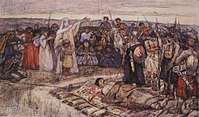
After Igor's death in 945, Olga ruled Kievan Rus as regent on behalf of their son Svyatoslav.[11] Little is known about Olga’s tenure as ruler of Kiev, but the Primary Chronicle does give an account of her accession to the throne and her bloody revenge on the Drevlians for the murder of her husband as well as some insight into her role as civil leader of the Kievan people.
Drevlian Uprising
.jpg)
After Igor’s death at the hands of the Drevlians, Olga assumed the throne because her three-year-old son Svyatoslav was too young to rule. The Drevlians, emboldened by their success in ambushing and killing the king, sent a messenger to Olga proposing that she marry his murderer, Prince Mal. Twenty Drevlian negotiators boated to Kiev to pass along their king’s message and to ensure Olga’s compliance. They arrived in her court and told the queen why they were in Kiev: “to report that they had slain her husband...and that Olga should come and marry their Prince Mal.”[12] Olga responded:
Your proposal is pleasing to me’ indeed, my husband cannot rise again from the dead. But I desire to honor you tomorrow in the presence of my people. Return now to your boat, and remain there with an aspect of arrogance. I shall send for you on the morrow, and you shall say, ‘We will not ride on horses nor go on foot’ carry us in our boat.’ And you shall be carried in your boat.[12]
When the Drevlians returned the next day, they waited outside Olga's court to receive the honor she had promised. When they repeated the words she had told them to say, the people of Kiev rose up, carrying the Drevlians in their boat. The ambassadors believed this was a great honor, as if they were being carried by palanquin. The people brought them into the court where they were dropped into the trench Olga had ordered dug the day before and buried alive. It is written that Olga bent down to watch them as they were buried and “inquired whether they found the honor to their taste.”[12]
Olga then sent a message to the Drevlians that they should send “their distinguished men to her in Kiev, so that she might go to their Prince with due honor.”[12] The Drevlians, unaware of the fate of the first diplomatic party, gathered another party of men to send “the best men who governed the land of Dereva.”[12] When they arrived, Olga commanded her people to draw them a bath and invited the men to appear before her after they had bathed. When the Drevlians entered the bathhouse, Olga had it set on fire from the doors, so that all the Drevlians within burned to death.[12]
Olga sent another message to the Drevlians, this time ordering them to “prepare great quantities of mead in the city where you killed my husband, that I may weep over his grave and hold a funeral feast for him.”[12] When Olga and a small group of attendants arrived at Igor's tomb, she did indeed weep and hold a funeral feast. The Drevlians sat down to join them and began to drink heavily. When the Drevlians were drunk, she ordered her followers to kill them, “and went about herself egging on her retinue to the massacre of the Drevlians.”[12] According to the Primary Chronicle, five thousand Drevlians were killed on this night, but Olga returned to Kiev to prepare an army to finish off the survivors.
The initial conflict between the armies of the two nations went very well for the forces of Kievan Rus’, who won the battle handily and drove the survivors back into their cities. Olga then led her army to Iskorosten (what is today Korosten), the city where her husband had been slain, and laid siege to the city. The siege lasted for a year without success, when Olga thought of a plan to trick the Drevlians. She sent them a message: “Why do you persist in holding out? All your cities have surrendered to me and submitted to tribute, so that the inhabitants now cultivate their fields and their lands in peace. But you had rather tide of hunger, without submitting to tribute.”[13] The Drevlians responded that they would submit to tribute, but that they were afraid she was still intent on avenging her husband. Olga answered that the murder of the messengers sent to Kiev, as well as the events of the feast night, had been enough for her. She then asked them for a small request: “Give me three pigeons...and three sparrows from each house.”[13] The Drevlians rejoiced at the prospect of the siege ending for so small a price, and did as she asked.
Olga then instructed her army to attach a piece of sulphur bound with small pieces of cloth to each bird. At nightfall, Olga told her soldiers to set the pieces aflame and release the birds. They returned to their nests within the city, which subsequently set the city ablaze. As the Primary Chronicle tells it: “There was not a house that was not consumed, and it was impossible to extinguish the flames, because all the houses caught fire at once.”[13] As the people fled the burning city, Olga ordered her soldiers to catch them, killing some of them and giving the others as slaves to her followers. She left the remnant to pay tribute.
Governance
Olga remained regent ruler of Kievan Rus with the support of the army and her people. She changed the system of tribute gathering (poliudie) in the first legal reform recorded in Eastern Europe. She continued to evade proposals of marriage, defended the city during the Siege of Kiev in 968, and saved the power of the throne for her son.
After her dramatic subjugation of the Drevlians, the Primary Chronicle recounts how Olga “passed through the land of Dereva, accompanied by her son and her retinue, establishing laws and tribute. Her trading posts and hunting-reserves are there still.”[13] As queen, Olga established trading-posts and collected tribute along the Msta and the Luga rivers. She established hunting grounds, boundary posts, towns, and trading-posts across the empire. Olga's work helped to centralize state rule with these trade centers, called pogosti, which served as administrative centers in addition to their mercantile roles. Olga's network of pogosti would prove important in the ethnic and cultural unification of the Russian nation, and her border posts began the establishment of national boundaries for the kingdom.
During her son's prolonged military campaigns, she remained in charge of Kiev, residing in the castle of Vyshgorod with her grandsons.
Christianity
The Primary Chronicle does not go into additional detail about Olga's time as regent, but does tell the story of her conversion to Christianity and subsequent effect on the acceptance of Christianity in Eastern Europe.
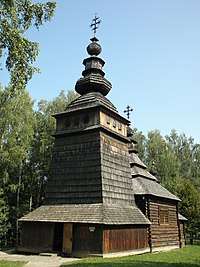
Conversion
In the 950s, Olga traveled to Constantinople, the capital of the Byzantine Empire, to visit Emperor Constantine VII.[14] Once in Constantinople, Olga converted to Christianity with the assistance of the Emperor and the Patriarch. While the Primary Chronicle does not divulge Olga's motivation for her visit or conversion, it does go into great detail on the conversion process, in which she was baptized and instructed in the ways of Christianity:
The reigning Emperor was named Constantine, son of Leo. Olga came before him, and when he saw that she was very fair of countenance and wise as well, the Emperor wondered at her intellect. He conversed with her and remarked that she was worthy to reign with him in his city. When Olga heard his words, she replied that she was still a pagan, and that if he desired to baptize her, he should perform this function himself; otherwise, she was unwilling to accept baptism. The Emperor, with the assistance of the Patriarch, accordingly baptized her. When Olga was enlightened, she rejoiced in soul and body. The Patriarch, who instructed her in the faith, said to her, ‘Blessed art thou among the women of Rus’, for thou hast loved the light, and quit the darkness. The sons of Rus’ shall bless thee to the last generation of thy descendants.’ He taught her the doctrine of the Church, and instructed her in prayer and fasting, in almsgiving, and in the maintenance of chastity. She bowed her head, and like a sponge absorbing water, she eagerly drank in his teachings. The Princess bowed before the Patriarch, saying, ‘Through thy prayers, Holy Father, may I be preserved from the crafts and assaults of the devil!’ At her baptism she was christened Helena, after the ancient Empress, mother of Constantine the Great. The Patriarch then blessed her and dismissed her.[15]
While the Primary Chronicle notes that Olga was christened with the name “Helena” after the ancient Saint Helena (the mother of Constantine the Great), Jonathan Shepard argues that Olga's baptismal name comes from the contemporary emperor's wife, Helena.[16] The observation that Olga was “worthy to reign with him in his city” suggests that the emperor was interested in marrying her. While the Chronicle explains Constantine's desire to take Olga as his wife as stemming from the fact that she was “fair of countenance and wise as well,” marrying Olga could certainly have helped him gain power over Rus’. The Chronicle recounts that Olga asked the emperor to baptize her knowing that his baptismal sponsorship, by the rules of spiritual kinship, would make marriage between them a kind of spiritual incest.[17] Though her desire to become Christian may have been genuine, this request was also a way for her to maintain political independence. After the baptism, when Constantine repeated his marriage proposal, Olga answered that she could not marry him since Church law forbade a goddaughter to marry her godfather:
After her baptism, the Emperor summoned Olga and made known to her that he wished her to become his wife. But she replied, ‘How can you marry me, after yourself baptizing me and calling me your daughter? For among Christians that is unlawful, as you yourself must know.’ Then the Emperor said, ‘Olga, you have outwitted me.’ He gave her many gifts of gold, silver, silks, and various vases, and dismissed her, still calling her his daughter.[15]
Francis Butler argues that the story of the proposal was a literary embellishment, describing an event that is highly unlikely to have ever actually occurred.[18] In fact, at the time of her baptism, Constantine already had an empress. In addition to uncertainty over the truth of the Chronicle’s telling of events in Constantinople, there is controversy over the details of her conversion to Christianity.[19] According to Russian sources, she was baptized in Constantinople in 957. Byzantine sources, however, indicate that she was a Christian prior to her 957 visit. It seems likely that she was baptized in Kiev around 955 and, following a second christening in Constantinople, took the Christian name Helen. Olga was not the first person from Rus’ to convert from her pagan ways-- there were Christians in Igor's court who had taken oaths at the St. Elias Church in Kiev for the Rus'–Byzantine Treaty in 945--but she was the most powerful Rus’ individual to undergo baptism during her life.[20]
Efforts to Christianize Kievan Rus'
The Primary Chronicle reports that Olga received the Patriarch's blessing for her journey home, and that once she arrived, she unsuccessfully attempted to convert her son to Christianity:
Now Olga dwelt with her son Svyatoslav, and she urged him to be baptized, but he would not listen to her suggestion, though when any man wished to be baptized, he was not hindered, but only mocked. For to the infidels, the Christian faith is foolishness. They do not comprehend it, because they walk in darkness and do not see the glory of God. Their hearts are hardened, and they can neither hear with their ears nor see with their eyes. For Solomon has said, ‘The deeds of the unrighteous are far from wisdom. Inasmuch as I have called you, and ye heard me not, I sharpened my words, and ye understood not. But ye have set at nought all my counsel, and would have none of my reproach. For they have hated knowledge, and the fear of Jehovah they have not chosen. They would none of my counsel, but despised all my reproof.[15]
This passage highlights the hostility towards Christianity in Kievan Rus’ in the tenth century. In the Chronicle, Svyatoslav declares that his followers would “laugh” if he were to accept Christianity.[15] While Olga tried to convince her son that his followers would follow his example if he converted, her efforts were in vain. However, her son agreed not to persecute those in his kingdom who did convert, which marked a crucial turning point for Christianity in the area.[21] Despite the resistance of her people to Christianity, Olga built churches in Kiev, Pskov, and elsewhere.[22]
Relations with the Holy Roman Emperor
Seven Latin sources document Olga's embassy to Holy Roman Emperor Otto I in 959. The continuation of Regino of Prüm mentions that the envoys requested the emperor to appoint a bishop and priests for their nation. The chronicler accuses the envoys of lies, commenting that their trick was not exposed until later. Thietmar of Merseburg says that the first archbishop of Magdeburg, Saint Adalbert of Magdeburg, before being promoted to this high rank, was sent by Emperor Otto to the country of the Rus' (Rusciae) as a simple bishop but was expelled by pagan allies of Svyatoslav I. The same data is repeated in the annals of Quedlinburg and Hildesheim.
Death
According to the Primary Chronicle, Olga died from illness in 969, soon after the Pechenegs' siege of the city.[23] When Svyatoslav announced plans to move his throne to the Danube region, the ailing Olga convinced him to stay with her during her final days. Only three days later, she passed away and her family and all of Kievan Rus’ wept:
Svyatoslav announced to his mother and his boyars, ‘I do not care to remain in Kiev, but should prefer to live in Perya-slavets on the Danube, since that is the centre of my realm, where all riches are concentrated; gold, silks, wine, and various fruits from Greece, silver and horses from Hungary and Bohemia, and from Rus’ furs, wax, honey, and slaves.’ But Olga made reply, ‘You behold me in my weakness. Why do you desire to depart from me?’ For she was already in precarious health. She thus remonstrated with him and begged him first to bury her and then to go wheresoever he would. Three days later Olga died. Her son wept for her with great mourning, as did likewise her grandsons and all the people. They thus carried her out, and buried her in her tomb. Olga had given command not to hold a funeral feast for her, for she had a priest who performed the last rites over the sainted Princess.[24]
Although he disapproved of his mother's Christian tradition, Svyatoslav heeded Olga's request that her priest, Gregory, conduct a Christian funeral without the ritual pagan burial feast.[25] Her tomb remained in Kiev for over two centuries, but was destroyed by the Mongolian-Tatar armies of Batu Khan in 1240.[25]
Legacy
Sainthood
At the time of her death, it seemed that Olga's attempt to make Kievan Rus’ a Christian territory had been a failure. Nonetheless, Olga's Christianizing mission would be brought to fruition by her grandson, Vladimir, who officially adopted Christianity in 988.[25] The Primary Chronicle highlights Olga's holiness in contrast to the pagans around her during her life as well as the significance of her decision to convert to Christianity:
Olga was the precursor of the Christian land, even as the day-spring precedes the sun and as the dawn precedes the day. For she shone like the moon by night, and she was radiant among the infidels like a pearl in the mire, since the people were soiled, and not yet purified of their sin by holy baptism. But she herself was cleansed by this sacred purification…. She was the first from Rus’ to enter the kingdom of God, and the son of Rus’ thus praise her as their leader, for since her death she has interceded with God in their behalf.[24]
In 1547, nearly 600 years after her 969 death, the Russian Orthodox Church named Olga a saint.[21] Because of her proselytizing influence, the Eastern Orthodox Church, the Ruthenian Greek Catholic Church, and the Ukrainian Greek Catholic Church call Saint Olga by the honorific Isapóstolos, "Equal to the Apostles". She is also a saint in the Roman Catholic Church. Olga's feast day is July 11th, the date of her death.[26] In keeping with her own biography, she is the patron of widows and converts.[27]
Olga is venerated as Saint in East Slavic-speaking countries where churches uses the Byzantine Rite: Eastern Orthodox Church (especially in Russian Orthodox Church), Greek Catholic Church (especially in the Ukrainian Greek Catholic Church), in churches with Byzantine Rite Lutheranism[28], in Roman Catholic Church in Russia (Latin rite)[29]
Churches and Monuments
.jpg)
- Cathedral of St. Olga, Kiev (inaugurated 2010)
- Church of Sts. Olha and Elizabeth, Lviv
- Church of Volodymyr and Olha, Khodoriv
- Church of Sts. Volodymyr and Olha, Podusiv, Peremyshliany Raion
- Saint Vladimir and Olha church, Staryi Dobrotvir, Kamenka-Buzky Raion
- Church of Saints Volodymyr and Olha, Birky, Yavoriv Raion
- Church of Saints Volodymyr and Olha, Horodok, Lviv Oblast
- Saint Olga Orthodox church in Korosten, Zhytomyr Oblast
- Sts. Volodymyr and Olha Ukrainian Catholic Church, Chicago
- Saints Vladimir and Olga Ukrainian Catholic Cathedral and Parish Hall, Winnipeg, Manitoba[30]
- Saints Vladimir and Olga Ukrainian Catholic Church, Dauphin, Manitoba[31]
- Saints Vladimir and Olga Ukrainian Catholic Church, Windsor, Ontario
- Saints Volodymyr and Olha Church, Woodville, South Australia
Modern Reception
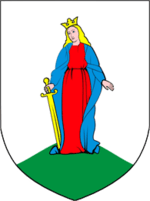
As an important figure in the history of Christianity, Olga's image as a saint lives on. But the question of Olga as a historical figure and character in the Primary Chronicle has been taken up in recent years.
Olga's historical characterization as a vengeful princess, juxtaposed with her estimation within the Orthodox tradition as a saint, has produced a variety of modern interpretations of her story. Scholars tend to be more conservative with their interpretations, focusing on what the Primary Chronicle makes explicit: Olga's role in the spread of Christianity to Eastern Europe and Russia. These texts, generally speaking, focus on Olga's role as advisor to her son, whose decision not to persecute Christians in the Kievan Rus' was a pivotal moment in the religious history of Russia and its neighboring lands. Academic work on Olga tends not to dwell on the narrative twists and turns of her story, instead focusing on extracting historical facts from the story.
Modern publications, however, have focused on her as an historical character. Journalists have penned articles with titles ranging from “Saint Olga of Kiev is the Best Warrior Princess You Never Knew”[32] to “Meet the Murderous Viking Princess Who Brought the Faith to Eastern Europe.”[6] These texts, written for a broader audience, tend to focus on Olga's exploits as a sort of historical drama. Her Viking heritage is always brought up, and often used as an explanation for her fiery spirit and military accomplishments. Authors focus on the most dramatic details of her story: her murder of two Drevlian negotiating groups, her wily deception of the Drevlian ruler, and her ultimate conquest of his people. A number of sources make her out to be a proto-feminist figure, a woman who did not allow contemporaneous expectations of gender roles to lock her out of the leadership role. Because there is little evidence to support the idea that Olga's rule was ever questioned by her people, this characterization of her rule is a medievalism — that is, an assumption made about history based not on facts but on preconceptions about the past, in this case the rigid relationship between gender and medieval rulership.
Though a number of these contemporary sources refer to Olga as a “warrior princess,” there is little evidence to suggest she actually participated in the fighting and killing of her enemies. Based on historical precedent, it is more likely that she was a commander of troops, a sort of general or commander-in-chief, than a warrior of particular skill. These assertions have still made their way into the public imagination, however, as evidenced by the appropriation of her image in the Eastern European heavy metal scene.
This duality of Olga's character — on the one hand a venerated saint, on the other a bloodthirsty commander of troops — has made her an attractive figure for subversive artists. Her image has been taken up in the heavy metal scene in some cases, most notably as the muse and cover figure for A Perfect Absolution, a concept album by French band Gorod about Olga of Kiev.
Gallery
- Illuminations from the Radziwiłł Chronicle
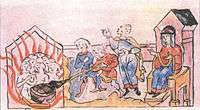 Olga's revenge for her husband's death
Olga's revenge for her husband's death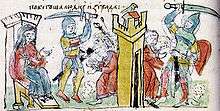 Fourth revenge of Olga: Burning of Derevlian capital Iskorosten
Fourth revenge of Olga: Burning of Derevlian capital Iskorosten.jpg) Reception of Olga by Constantine VII
Reception of Olga by Constantine VII
See also
- Princess Olga Pskov Airport
- Order of Princess Olga (established in Ukraine in 1997)
- Christianization of Kievan Rus'
- A Perfect Absolution - concept album by French band Gorod about Olga of Kiev
References
- Vernadsky 1948, p. 39.
- "Saint Olga | Biography, Facts, & Patron Saint of". Encyclopedia Britannica. Retrieved 2019-05-01.
- "Святая княгиня Ольга". Русская вера (in Russian). Retrieved 2019-08-08.
- Michael S. Flier, "St Olga," in The Oxford Dictionary of the Middle Ages, ed. Robert E. Bjork (Oxford: Oxford University Press, 2010).
- "Princess Olga of Kiev," Russiapedia, https://russiapedia.rt.com/prominent-russians/history-and-mythology/princess-olga-of-kiev/.
- Addison Nugent, "Meet the Murderous Viking Princess Who Brought the Faith to Eastern Europe," OZY, January 22, 2018, https://www.ozy.com/flashback/meet-the-murderous-viking-princess-who-brought-the-faith-to-eastern-europe/83251.
- Thomas J. Craughwell, Saints Behaving Badly: The Cutthroats, Crooks, Trollops, Con Men, and Devil-Worshippers Who Became Saints (New York: Doubleday, 2006), 83.
- Thomas Noonan, "European Russia, C. 500–c. 1050," in The New Cambridge Medieval History, ed. Timothy Reuter (Cambridge: Cambridge University Press, 2008), 508.
- Craughwell, Saints Behaving Badly: The Cutthroats, Crooks, Trollops, Con Men, and Devil-Worshippers Who Became Saints, 84.
- Talbot, Alice-Mary; Sullivan, Dennis F., eds. (2005), The History of Leo the Deacon: Byzantine Military Expansion in the Tenth Century, Washington: Dumbarton Oaks, pp. 156, 157 (esp. note 99), ISBN 978-0-88402-324-1
- Clements 2012, p. 7.
- Cross, Samuel Hazzard, Olgerd P. Sherbowitz-Wetzor, and Nestor. The Russian Primary Chronicle: Laurentian Text. Mediaeval Academy of America No. 60. Cambridge, Mass.: Mediaeval Academy of America, 1953. 79-80 (line 6453).
- Primary Chronicle 80-1 (line 6454).
- Thomas J. Craughwell, Saints Behaving Badly: The Cutthroats, Crooks, Trollops, Con Men, and Devil-Worshippers Who Became Saints, 86.
- Primary Chronicle 82.
- Jonathan Shepard, "The Origins of Rus’ (c.900–1015)," ed. Maureen Perrie (Cambridge: Cambridge University Press, 2006), 58.
- Francis Butler, "Ol'Ga's Conversion and the Construction of Chronicle Narrative," The Russian Review 67, no. 2 (April 2008): 240.
- Francis Butler, "Ol'Ga's Conversion and the Construction of Chronicle Narrative," 234.
- Omeljan Pritsak, "When and Where Was Ol'ga Baptized?" Harvard Ukrainian Studies 9, no. 1/2 (June 1985): 5-24.
- "Olga (c. 890–969)," Women in World History: A Biographical Encyclopedia, 2002, https://www.encyclopedia.com/women/encyclopedias-almanacs-transcripts-and-maps/olga-c-890-969.
- Addison Nugent, "Meet the Murderous Viking Princess Who Brought the Faith to Eastern Europe."
- Craughwell, Saints Behaving Badly: The Cutthroats, Crooks, Trollops, Con Men, and Devil-Worshippers Who Became Saints, 88.
- Ciaran Conliffe, "Saint Olga, Queen of Kiev," HeadStuff, May 10, 2016, , https://www.headstuff.org/culture/history/saint-olga-queen-of-kiev/.
- Primary Chronicle 86.
- "Olga (c. 890–969)," Women in World History: A Biographical Encyclopedia, 2002, https://www.encyclopedia.com/women/encyclopedias-almanacs-transcripts-and-maps/olga-c-890-969.
- Michael S. Flier, "St Olga," in The Oxford Dictionary of the Middle Ages, ed. Robert E. Bjork (Oxford: Oxford University Press, 2010).
- The Editors of Encyclopaedia Britannica, "St. Olga," Encyclopædia Britannica, January 01, 2019, https://www.britannica.com/biography/Saint-Olga.
- "Notable Lutheran Saints". Resurrectionpeople.org.
- "РИМСКО-КАТОЛИЧЕСКИЙ ПРИХОД СВЯТОЙ ОЛЬГИ" [St. Olga Roman Catholic Parish]. Retrieved September 15, 2019.
founded in 1991
- "Historic Sites of Manitoba: Sts. Vladimir and Olga Ukrainian Catholic Cathedral and Parish Hall (115 McGregor Street, Winnipeg)". www.mhs.mb.ca. Retrieved 2019-05-01.
- "Historic Sites of Manitoba: Sts. Vladimir and Olga Ukrainian Catholic Church (Valley River, RM of Dauphin)". www.mhs.mb.ca. Retrieved 2019-05-01.
- Natasha Sheldon, "Saint Olga of Kiev Is the Best Warrior Princess You Never Knew," HistoryCollection.co, February 12, 2018, https://historycollection.co/saint-olga-kiev-best-warrior-princess-never-knew/.
Sources
- Vernadsky, George (1948). Kievan Russia. Yale University Press.CS1 maint: ref=harv (link)
External links
| Wikimedia Commons has media related to Olga of Kiev. |
| Preceded by Igor of Kiev |
Princess of Kiev as Regent 945–960s |
Succeeded by Sviatoslav the Brave |